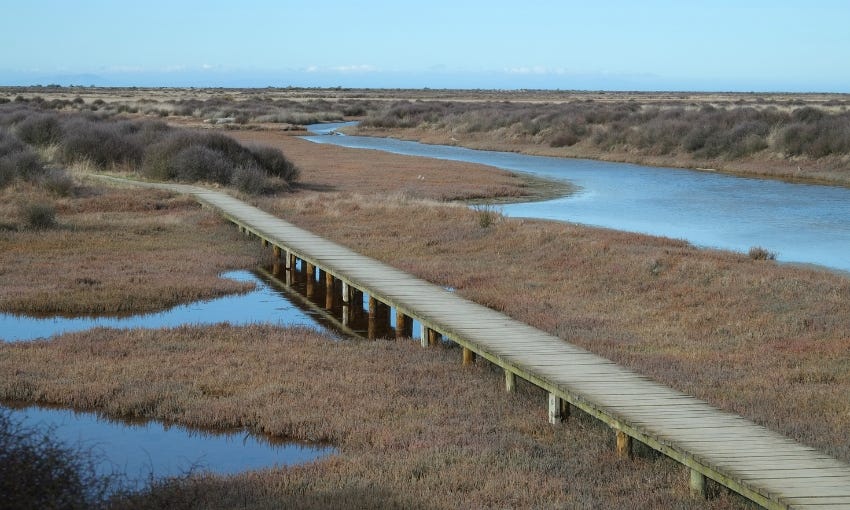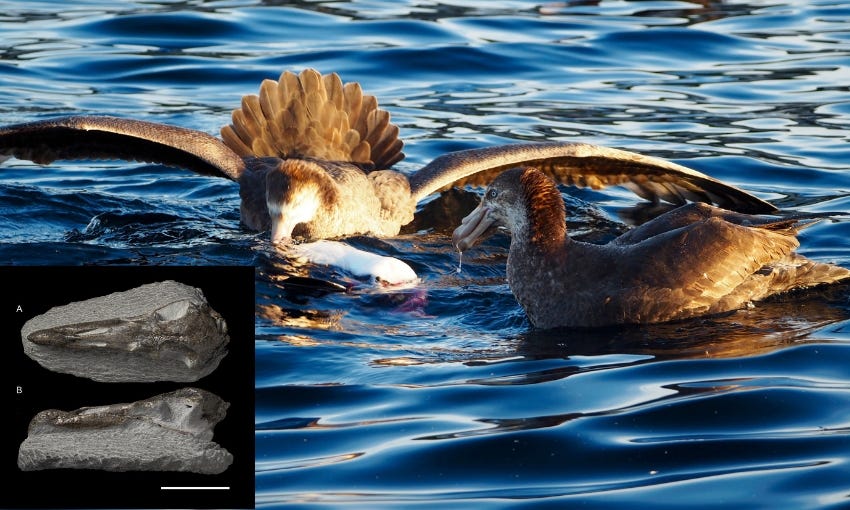The untapped potential of blue carbon
Don’t overlook New Zealand’s saltmarshes and their carbon-sequestering superpowers.
Kia ora, welcome to Future Proof, brought to you by Electric Kiwi.
Saltmarsh at Wairau Lagoon.
When it comes to sucking carbon out of the atmosphere, we usually turn to tree planting. But there’s an often overlooked opportunity to diversify our carbon sequestration portfolio, and it has me channeling my inner Shrek: swamps. Tidal wetlands – mangroves, seagrass meadows and saltmarshes – come under the “blue carbon” umbrella, which refers to the carbon stored in oceans and coastal ecosystems.
These muddy margins of our coastlines may not be glamorous, but they’re powerhouses when it comes to sequestering and storing carbon – in particular, stockpiling it in the soils beneath the vegetation. Blue carbon habitats can store several times more carbon than equivalent areas of forest. They also provide heaps of other benefits, says marine ecologist Anna Berthelsen, like protecting people and infrastructure from flooding, providing a home for plants and animals, and offering cultural opportunities.
Berthelsen, from the Cawthron Institute, is part of a team who investigated the feasibility of blue carbon credits – a scheme where the benefits from protecting and restoring tidal wetlands are sold to those wanting to offset an activity. “It’s very important to prioritise reducing gross emissions before going down the track of offsetting,” says Berthelsen. “But it’s a way to funnel funds towards removing emissions from the atmosphere, improving livelihoods and protecting nature.”
The idea goes like this: take a degraded wetland, and start taking actions to restore it – like returning tidal flows by removing drainage, or replanting. This restoration then leads to more carbon storage (as well as the aforementioned raft of other benefits) compared to the baseline scenario. The relative positive outcomes can then be sold as blue carbon credits that fund the restoration.
Commissioned by The Nature Conservancy and led by Ekos, the investigation delved into the nitty-gritty detail of how such a blue carbon credit system might work in New Zealand, focusing on six study sites. While one seagrass site proved tricky to analyse, five saltmarshes showed promise. This is a type of soggy reed-land that’s regularly flooded with saltwater by the tides.
In short: “There’s a real opportunity for tidal salt marsh restoration blue carbon projects,” says Berthelsen. The resulting report recommends a saltmarsh pilot project alongside a nationwide inventory of tidal wetland ecosystems with blue carbon potential.
Recently, the emissions-reducing efficacy of voluntary forest carbon credits has come under scrutiny. Nonetheless, it’s clear we can’t afford to miss investing in our saltmarsh superheroes. Our climate-resilient future looks swampy, and I’m here for it.
Turns out, Kiwis just want simple, fair energy and broadband, who knew? It’s been barely a year since Electric Kiwi launched broadband and they’ve already picked up the Canstar Blue award for bundled utilities with 5 star reviews from customers on value, service and everything else.
So why not join today? With Electric Kiwi you get guaranteed savings on power, no contracts and an hour of free off-peak power every day.
Plus, join Electric Kiwi Broadband before the end of February and go in the draw to win a whole year’s free Fibre. T&Cs and eligibility criteria apply.
A greener send-off?
Future Proof reader Sally asked me to take a look at funeral options with minimal environmental impact, after she came across this piece in the Washington Post. Both caskets and cremation come with hefty environmental footprints, but in some US states you can choose human composting, alkaline hydrolysis, or natural burial as greener alternatives. Only the latter is currently an option in New Zealand – it involves no embalming, burial in either a shroud or untreated timber, natural fibre clothing, and either a tree or a rock in place of a headstone. In 2019, the Ministry of Health considered new body disposal methods as part of a review of the Burial and Cremation Act 1961. Public submissions supported greater sustainability in the funeral industry, but new legislation stemming from this review is yet to emerge. But ultimately: “... from a climate perspective, the way you live will always eclipse what happens after you die.”
Fossil fuel companies extract record-breaking profits
Oil prices driven sky-high by the war in Ukraine have boosted 2022 profits to new record-breaking highs for both Exxon and Shell. Despite Shell’s “obscene” $40 billion profits, it won’t be accelerating investment in its “renewables and energy solutions” unit, keeping the unit’s budget steady at $3.5 billion. Even this figure overstates Shell’s spending on renewables, a non-profit alleges. The Global Witness group has reported Shell to the US financial regulator for mislabelling, as a decent chunk of that $3.5 billion appears to be funding gas, rather than solar or wind.
Do we have enough minerals to power renewable tech?
Yes! While we do require vast quantities of minerals to transition to renewable tech, the amount required for this shift is well within existing reserves. The challenge will be ensuring these minerals are extracted in a way that doesn’t cause outsized harm to environments and people. As for where to put this renewable tech, new research finds that putting solar panels in grazing fields is good for sheep, while a prototype space-based solar array prepares for tests in orbit.
The Spinoff's independent, homegrown journalism is only possible because of the support of our members. Their generous donations power all our work and help keep it freely available to all. Tautoko The Spinoff this year by becoming a member, making a new donation or encouraging your organisation to donate.
More stories:
How to deal with eco-anxiety in the wake of a natural disaster
Palm oil isn’t actually that bad anymore
How do we know climate change played a role in the Auckland floods? The Spinoff’s Toby Manhire investigates
Why the world’s most famous climate goal is widely misunderstood, and what it actually means (paywall)
A draft bill to ban new mines on conservation land is underway
Kea spotted in Christchurch in first city sighting of mountain parrot in decades
The Climate Inequality Report 2023 finds that the emissions divide between rich and poor is more important than the gap between countries
Algal bloom probably behind masses of dead sealife washed up in Hawke’s Bay, scientists say
Northern giant petrels eat a dead penguin at the Snares Islands, about 100km southwest of Rakiura. Inset: Giant petrel fossil skull. Image credits: Ellen Rykers / Inset: Jean-Claude Stahl/Te Papa.
To finish this week, a very cool fossil find from Taranaki: a three-million-year old giant petrel fossil skull. Just like the gulls you see at the beach, giant petrels are scavengers – but these big birds are way more metal, getting covered in blood and goo as they devour the carcass of a penguin or seal. In more good news for fossil lovers, Foulden Maar has been purchased by Dunedin City Council, saving the site’s incredible treasure trove of fossils from becoming pig food.
Rock on,
Ellen
Got some feedback about Future Proof or topics you’d like covered? Get in touch with me at futureproof@thespinoff.co.nz














Could you foresee a carbon trading market in ecosystem services in the U.S. in the next decade?
Could you envision it including salt mash?
The U.S. Southeast and Gulf coast coastlines have large expanses of salt marsh.